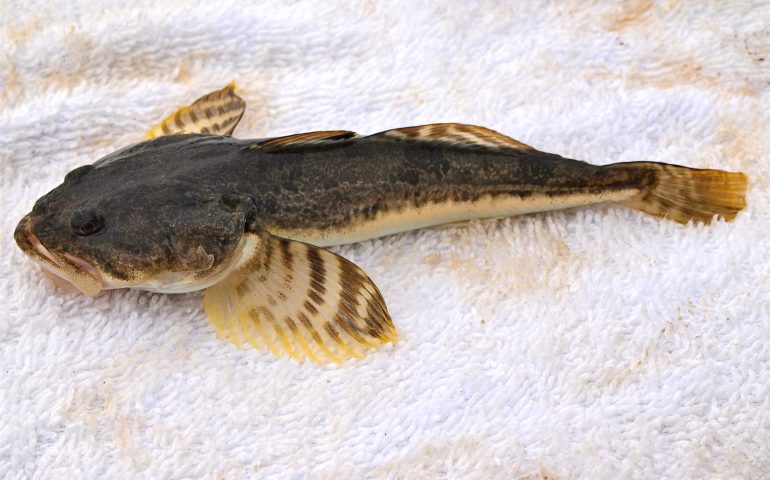Sculpins: Family Cottidae
Species: Leptocottus armatus (Girard, 1854); from the Greek words leptos (slender) and cottus (a sculpin); and the Latin word armatus (armed, referring to the strong antler-like preopercular spine).
Alternate Names: Commonly called bullhead; also smooth cabezon, buffalo sculpin, and smooth sculpin. Called charrasco de astas in Mexico.
Identification: Noted primarily by the strong spine that precedes the gill cover on each side, and a spot at the rear of the first dorsal fin. Their coloring is tan, brown, or grayish above and white or yellow below.
Size: Up to 18.9 inches; most caught from piers are 6-8 inches long (although I did catch a staghorn sculpin nearly 16 inches long while fishing from a pier at Port Angeles in the Strait of Juan de Fuca in Washington).
Range: Bahia San Quentin, Baja California, to Izembek Lagoon, southeastern Bering Sea coast, Alaska.
Habitat: Shallow water, both oceanfront and in bays.
Piers: Virtually every pier in the state with a sand or mud bottom seems to see this pesky little fish. I’ve caught “bullheads” at the most southern pier in the state, the Imperial Beach Pier (which sits just a few miles upshore from Mexico), and I’ve caught them at the most northern pier, the “B” Street Pier in Crescent City (which isn’t too far away from Oregon). At both piers, and many piers in-between, there have been times when I could hardly keep the bait stealers off my hooks. However, they are most common north of Pismo Beach. Probably more staghorn sculpin are caught from San Francisco Bay and Humboldt Bay piers than any other type of fish (although the numbers in San Francisco Bay seem to have seen seen a recent drastic decline).
Shoreline: Frequently caught by shore anglers fishing in bays.
Boats: An inshore species, rarely taken from boats.
Bait and Tackle: Will hit almost any bait although they especially like small pieces of pile worm or small strips of anchovy. They’re usually caught on the bottom while fishing for other fish.
Food Value: Although some groups of anglers do keep them and fry them up like catfish, I’ve been told they have a rather bland taste. One book from Canada says that they’re most suitable for a “fish paste.” Since the thought of staghorn paste on Ritz crackers leaves me sort of numb, I’d throw ‘em back.
Comments: I rarely saw staghorn sculpins caught at any southern California pier during the 1960s and 1970s. However, during the ‘80s I saw an increasing number of the little critters grabbing SoCal baits. I don’t know why, I’m just reporting what I saw. “Bullheads” do make excellent bait for striped bass in the San Francisco Bay Area. With the exception of cabezon, most sculpins caught from California piers are small (if not tiny) and strictly incidental catches when fishing for other species.
Nevertheless you’ve got to love this family of fish. What other family has fish with names like hookear, roughcheek, padded, scalyhead, smoothhead, bonehead, rosylip, roughback, sharpnose, mosshead, woolly, bald, spinyhead, bull, smoothcheek, armorhead, pit-head, thorny, eyeshade, snubnose, pored, spinynose, smoothgum, grunt and manacled sculpin? Sounds like some great names for mob members. And don’t forget my personal favorite—the blob sculpin—whose actual appearance is even more pathetic than its name. The family sounds like they deserve their own TV show on HBO.

Such a nice and interesting comments. You make learning fun!
Thanks for the nice comment.
It should be noted that they are venomous and can give you a a pretty painful price too. Lol. I just get them off while avoiding the fins and get rid of them myself.
Painful prick I meant. Lol.
Theyre venomous?? My dad puts them on the hooks and stuff and he told me her never got stung.
A very light toxin, nothing like the sting from a scorpionfish or the toxins in stingrays.
yep these little bastards pack a painful sting in the gill plates from those staghorns. And can leave a lump in your hand for years.
They have a lot of bullheads through the san francisco bay. I recommend fishing at the Vallejo waterfront/Marina. Just set your rods up for them to catch them or you can just buy a shrimp trap and put anchovies or sardines in them but sardines work a little better than anchovies.